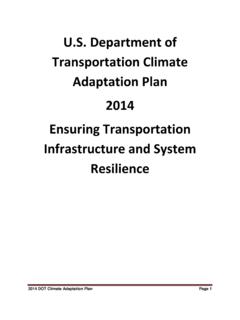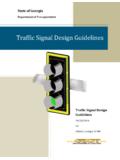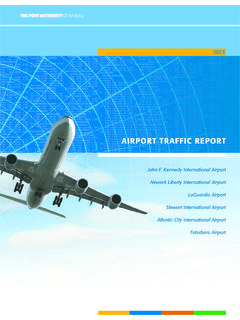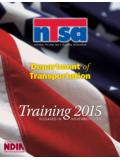Transcription of CONNECTICUT DEPARTMENT OF TRANSPORTATION
1 CONNECTICUT DEPARTMENT . OF TRANSPORTATION . ( The Charter Oak Charles D. Brownell, 1857). highway design manual . 2003 Edition (Including Revisions to February 2013). ( Customary Units). PREFACE. The CONNECTICUT highway design manual has been developed to provide uniform design practices for preparing roadway plans. The manual presents most of the information normally required in the design of a typical highway project. The highway designer should attempt to meet all criteria presented in the manual ; however, the manual should not be considered a standard that must be met regardless of impacts. The highway designer must consider the social, economic or environmental impacts that result from the design values selected. The highway designer should develop solutions that meet the DEPARTMENT 's operational and safety requirements while preserving the aesthetic, historic or cultural resources of an area.
2 The DEPARTMENT has designated certain highways or segments of highways that abut significant natural or cultural features as Scenic Highways. The criteria for and listing of Scenic Highways is included in an Appendix to Chapter One. Designers must exercise good judgment on individual projects and, frequently, they must be imaginative, innovative and flexible in their approach to highway design . Designers are reminded that the projects they work on are not just DEPARTMENT projects, but everyone's project. The DEPARTMENT has developed alternative design standards for bridge rehabilitation projects under the Local Bridge Program. These alternative design standards may be applied to municipally maintained bridges on facilities that are functionally classified as Rural Local Roads, Rural Minor Collectors or Urban Local Streets.. The DEPARTMENT of TRANSPORTATION wishes to thank the following organizations for their assistance during the development of this manual : Federal highway Administration, Council of Small Towns, Rural Development Council, CONNECTICUT Trust for Historic Preservation, Councils of Elected Officials, Regional Councils of Government, Regional Planning Agencies, and CONNECTICUT Council on the Arts.
3 FOREWORD. CONNECTICUT is blessed with an exceptionally strong sense of time and place, its bustling towns and quiet villages linked by a web of roads, some of which began before the coming of Columbus as trails and paths linking Indian settlements. Whether local resident or visitor to the State, drivers know the experience of the journey can be a lot more than just getting from one point to the next. The CONNECTICUT landscape is one of great diversity. There are very few places in the country where you can see such varied and distinctive landscapes, all within a two-hour drive. CONNECTICUT has mountainous and rolling uplands dropping down to broad agricultural plateaus, dissected by rocky, fast-moving streams. CONNECTICUT has broad and fertile river valleys framed by distinctive landforms that have supported most of the urban population for its recent history. CONNECTICUT has distinctive coastal plains separated by rocky outcrops and extensive salt marshes.
4 Beyond exceptional natural land forms, the State is blessed with a similar range of diversity in the ways people have inhabited the land. As was the case along much of the eastern seaboard, people settled CONNECTICUT in a series of episodes that adapted to conditions of the land and changes in technology. For the first 120 or so years, the economy was agrarian, and the landscape was covered with small farms and homesteads. As technology evolved and industrialization began, these forms shifted and urban centers developed. There are scenic places in both of these landscape types. Within the urban regions, the scenic qualities are a result of tenacious efforts by citizens to preserve what is left of the visible links between the land and people. Here, the scenic qualities are a result of relative scarcity. In the more rural regions, the scenic qualities are a result of tenacious efforts at making a living from the land.
5 Scenic qualities are a result of continuous stewardship and care. The rich heritage of CONNECTICUT needs to continue. highway and bridge engineers, amongst many others, are key players in achieving this goal. Engineers have the challenge to not only maintain and upgrade the TRANSPORTATION system to meet the operational and safety needs of the DEPARTMENT , but also to minimize the environmental, historic, cultural, aesthetic, social and economic impacts. January 2012 TABLE OF CONTENTS TC-1. TABLE OF CONTENTS. CONNECTICUT highway design manual . Preface Foreword Table of Contents Date of Revisions Chapter One .. manual USAGE. Chapter Two .. GEOMETRIC design OF EXISTING HIGHWAYS. (3R Non-Freeway Projects). Chapter Three .. GEOMETRIC design OF EXISTING HIGHWAYS. (4R Freeway Projects)(Spot Improvements)(Pavement Preservation Projects). Chapter Four ..RURAL HIGHWAYS AND ROADS. (New Construction/Major Reconstruction).
6 Chapter Five .. URBAN HIGHWAYS AND STREETS. (New Construction/Major Reconstruction). Chapter Six .. design CONTROLS. Chapter Seven .. SIGHT DISTANCE. Chapter Eight .. HORIZONTAL ALIGNMENT. Chapter Nine .. VERTICAL ALIGNMENT. Chapter Ten .. CROSS SECTIONS. Chapter Eleven .. INTERSECTIONS AT-GRADE. Chapter Twelve ..INTERCHANGES. Chapter Thirteen .. ROADSIDE SAFETY. Chapter Fourteen .. MAINTENANCE AND PROTECTION OF TRAFFIC. THROUGH CONSTRUCTION ZONES. Chapter Fifteen .. SPECIAL design ELEMENTS. Glossary Index TC-2 TABLE OF CONTENTS January 2012. February 2013 TABLE OF CONTENTS TC-3. LIST OF SECTIONS SHOWING LATEST DATE OF REVISIONS. ORIGINAL ISSUE DATE IS DECEMBER 2003. Section Section Number Date Number Date January 2011 December 2006. December 2006 Appendix 1 December 2006 Appendix 2 Figure 2-3A Figure 2-3B Figure 2-3C Figure 2-3D Figure 2-3E Figure 2-3F Figure 2-3G Figure 2-3H Figure 2-3I Chapter 13 Revised and Reissued July 2012.
7 TC-4 TABLE OF CONTENTS February 2013. LIST OF SECTIONS SHOWING LATEST DATE OF REVISIONS. ORIGINAL ISSUE DATE IS DECEMBER 2003. Section Section Number Date Number Date December 2006. February 2013 January 2012 February 2013 February 2013 February 2013 Figure 4A Figure 4B Figure 4C Figure 4D Figure 4E Figure 4F Figure 4G Figure 4H December 2006 Figure 4I December 2006 January 2012. Figure 4J December 2004 Figure 5A Figure 5B Figure 5C January 2012. Figure 5D Figure 5E Figure 5F Figure 5G January 2012. Figure 5H Figure 5I Figure 5J December 2006 Figure 5K December 2006 Figure 5L December 2003 Figure 5M December 2006 December 2006. December 2006. Chapter 13 Revised and Reissued July 2012. February 2013 TABLE OF CONTENTS TC-5. LIST OF SECTIONS SHOWING LATEST DATE OF REVISIONS. ORIGINAL ISSUE DATE IS DECEMBER 2003. Section Section Number Date Number Date December 2004 December 2006. December 2006 December 2004 January 2012.
8 January 2012. January 2012. January 2012 December 2006. February 2013. December 2006. December 2006. December 2006. Chapter 13 Revised and Reissued July 2012. TC-6 TABLE OF CONTENTS February 2013. LIST OF SECTIONS SHOWING LATEST DATE OF REVISIONS. ORIGINAL ISSUE DATE IS DECEMBER 2003. Section Section Number Date Number Date December 2006 December 2006 December 2006 February 2013. December 2006 11-10. Appendix February 2013. December 2006 December 2006 July 2012. January 2012 July 2012. January 2012 January 2009. December 2004 December 2006 January 2009. July 2004 December 2006 January 2009. January 2009 January 2009. Appendix July 2012. Chapter 13 Revised and Reissued July 2012. February 2013 TABLE OF CONTENTS TC-7. LIST OF SECTIONS SHOWING LATEST DATE OF REVISIONS. ORIGINAL ISSUE DATE IS DECEMBER 2003. Section Section Number Date Number Date Chapter 13 Revised and Reissued July 2012. TC-8 TABLE OF CONTENTS February 2013.
9 LIST OF SECTIONS SHOWING LATEST DATE OF REVISIONS. ORIGINAL ISSUE DATE IS DECEMBER 2003. Section Section Number Date Number Date Appendix A-1 January 2011 January 2011 January 2011 January 2011 January 2009 February 2013 January 2009 Chapter 13 Revised and Reissued July 2012. February 2013 TABLE OF CONTENTS TC-9. LIST OF SECTIONS SHOWING LATEST DATE OF REVISIONS. ORIGINAL ISSUE DATE IS DECEMBER 2003. Section Section Number Date Number Date Glossary December 2006. Index December 2006. Chapter 13 Revised and Reissued July 2012. TC-10 TABLE OF CONTENTS February 2013. Chapter 13 Revised and Reissued July 2012. January 2011 manual USAGE 1(i). Chapter One manual USAGE. Table of Contents Section Page 1-1(1). Objective .. 1-1(1). 1-1(1). Basis for 1-1(2). manual SUMMARY .. 1-2(1). Introduction .. 1-2(1). Chapter Two Geometric design of Existing Highways (3R Non-Freeway Projects) .. 1-2(1). Chapter Three Geometric design of Existing Highways (4R Freeway Projects) (Spot Improvements).
10 (Pavement Resurfacing and Reclamation Projects) .. 1-2(1). Chapter Four Rural Highways and Roads (New Construction/Major Reconstruction) .. 1-2(2). Chapter Five Urban Highways and Streets (New Construction/Major Reconstruction) .. 1-2(2). Chapter Six design Controls .. 1-2(2). Chapter Seven Sight Distance .. 1-2(3). Chapter Eight Horizontal Alignment .. 1-2(3). Chapter Nine Vertical Alignment .. 1-2(3). Chapter Ten Cross Sections .. 1-2(3). Chapter Eleven Intersections At-Grade .. 1-2(4). Chapter Twelve Interchanges .. 1-2(4). Chapter Thirteen Roadside Safety .. 1-2(4). Chapter Fourteen Temporary Traffic Control .. 1-2(5). Chapter Fifteen Special design Elements .. 1-2(5). APPENDICES. Criteria for Designation of Scenic Highways 1(ii) manual USAGE January 2011. January 2011 manual USAGE 1-1(1). Chapter One manual USAGE. OVERVIEW. Objective The CONNECTICUT highway design manual has been prepared to provide guidance on the geometric design of bridge and highway projects.
















